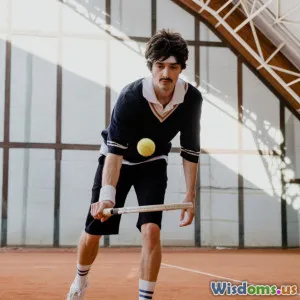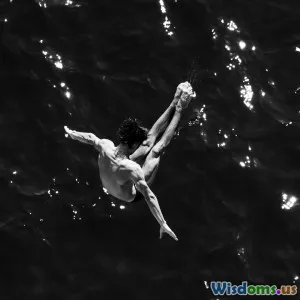
The Power of Visualization: How Elite Athletes Stay Motivated
8 min read Discover how elite athletes use visualization to boost motivation and achieve peak performance. (0 Reviews)
The Power of Visualization: How Elite Athletes Stay Motivated
Introduction
Imagine standing on the world stage, seconds away from a life-changing moment. You feel the roar of the crowd, the adrenaline rushing, and your mind is not racing chaotically—it’s calm, focused, and precisely tuned to succeed. This is the secret many elite athletes share: the power of visualization. Visualization is much more than wishful thinking; it is a scientifically backed mental strategy that fuels motivation, sharpens focus, and boosts performance.
In this article, we dive into how elite athletes use visualization, combining mental rehearsal and vivid imagery to stay motivated and achieve peak performance. Whether you are an aspiring athlete, a driven professional, or someone interested in the intersection of mind and motivation, uncovering these techniques could transform the way you approach your goals.
Understanding Visualization: More Than Just Daydreaming
Visualization, sometimes called mental imagery or mental rehearsal, is the process of creating a detailed, sensory-rich picture of a desired outcome or activity in the mind’s eye. Elite athletes don’t just imagine winning; they mentally simulate the entire process—from preparation and strategy to execution and victory.
According to sport psychologist Dr. Jim Taylor, visualization helps bridge the gap between the mind and body. This mental practice activates neural pathways similar to those engaged during actual physical performance. For example, studies using functional MRI scans have shown that when athletes visualize a skill like shooting free throws or executing complex gymnastic moves, their brains light up in regions responsible for movement control, coordination, and motivation.
Key Benefits
- Enhances motivation by vividly focusing on goals and rewards.
- Reduces anxiety by building familiarity with performance situations.
- Improves skill execution via neural pathway priming.
- Boosts confidence through mental mastery and positive expectations.
How Elite Athletes Use Visualization to Stay Motivated
1. Creating a Clear and Detailed Vision
Michael Phelps, the most decorated Olympian in history, was renowned for his visualization skills. He reported mentally swimming every race multiple times before actual competition. By vividly picturing each stroke, turn, and finish, he prepared his mind as much as his body.
Phelps’s coach Bob Bowman emphasized that this mental clarity helped Michael maintain unwavering motivation, because he wasn’t merely hoping to succeed; he was envisioning it in exact detail.
2. Overcoming Challenges and Building Resilience
Visualization also allows athletes to mentally rehearse adversity and setbacks. Tennis legend Serena Williams has described mentally playing through difficult match scenarios, like trailing in points or dealing with hostile crowds. This mental toughness cultivates grit and motivation to push through strain when reality becomes demanding.
3. Reinforcing Positive Self-Talk
Visual imagery is often paired with affirmations or motivational self-talk. Novak Djokovic, a top-ranked tennis player, combines visualization with phrases that reinforce focus and calmness. This synergistic approach enhances motivation by reducing fear and empowering belief.
4. Setting Incremental Micro-Goals
Elite athletes use visualization not just for final wins but for intermediate goals—nailing a perfect start, hitting form cues, or maintaining strategic focus. Weightlifter Lasha Talakhadze visualizes each segment of his lifts, sharpening motivation through attainable, visible progress.
Scientific Insights Supporting Visualization
A landmark meta-analysis in the Journal of Sports Sciences (2018) evaluated over 30 studies and found that mental imagery interventions yielded consistent improvements in motor performance, concentration, and anxiety management. The physiological underpinning is tied to the brain’s motor cortex and mirror neuron systems which simulate movement and emotional states.
Dr. Guang Yue’s work at Cleveland Clinic demonstrated that visualization alone could increase muscle strength by 13.5%, highlighting the power of the mind to prime the body.
Neuroscientist Dr. Daniel Glimcher explains that the dopaminergic reward systems activate when one envisions success, releasing neurochemicals that spur motivation and drive. This brain-behavior link is what distinguishes effective athletes—the ability to mentally generate a compelling ‘reward’ before physical rewards manifest.
Practical Techniques to Harness Visualization for Your Own Motivation
Technique 1: Sensory Immersion
Rather than vague daydreams, focus on involving all senses. Imagine the sounds of the crowd, the feeling of the equipment, even scents or temperature. This multi-sensory experience enriches mental rehearsal.
Technique 2: Regular and Consistent Practice
Visualization should be embedded as a daily mental workout. Elite athletes often dedicate 10-15 minutes daily to visualization routines, reinforcing motivation and familiarizing their brains with success scenarios.
Technique 3: Combine With Physical Practice
Visualization acts as a potent supplement to physical training—not a replacement. Athletes use it to prime the mind and body, ensuring cohesiveness and readiness.
Technique 4: Embrace Positive Emotional States
Vividly evoke emotions associated with success, such as pride, joy, or satisfaction. Emotional engagement intensifies motivation and encodes memories of achievement.
Conclusion
Visualization transcends mere imagination. It is a powerful psychological and neurological tool that propels elite athletes to bulletproof motivation and exceptional performance. Through detailed mental imagery, confronting adversity, and aligning emotion with goals, athletes transform mental rehearsals into real-world success.
Whether you strive to excel in sports, business, or personal ambitions, cultivating the art of visualization can provide you with a potent motivational edge. Begin crafting your vivid mental scenarios today—it might just be the decisive factor that turns your dreams into achievements.
Harness the power of your mind. Visualize your success before you chase it.
Rate the Post
User Reviews
Popular Posts




















